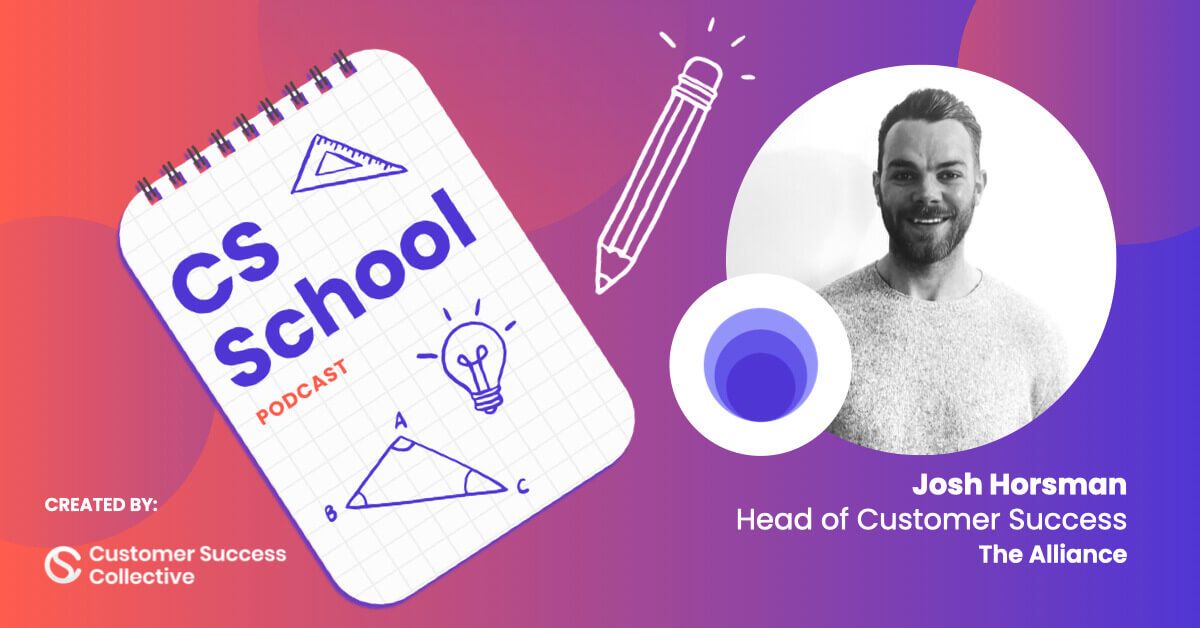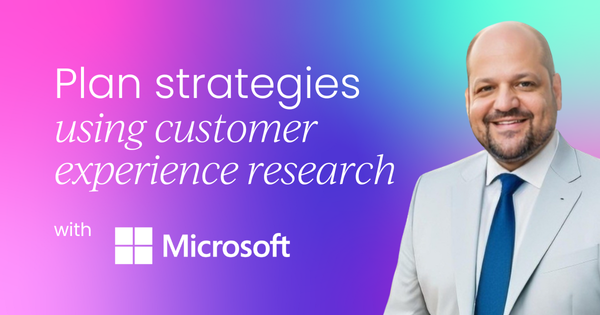In pursuit of business excellence, your true north star is always a profound understanding of the customer – or as we say, KYC – “know your customer.”
As a leader in customer success (CS) and experience, I've come to realize that the bedrock of any transformative strategy is deeply embedded in the rich soil of customer experience (CX) research. It's a realm where data and human experiences converge, offering a treasure trove of insights that, when harnessed, can unlock untold potential for innovation, co-innovation, and growth.
My journey in the tech industry has been a testament to the power of customer obsession. I've seen firsthand that when you really dig into researching what customers experience, it can show us the way forward. It's not just about figuring out what they want or need right away, but also getting the unspoken stuff they expect and the little things that sway their choices. It's a fascinating exploration that demands both empathy and analytical rigor, a balance that, when struck, can lead to strategies that not only resonate with our audience but also inspire and delight them.
This article extends beyond a simple prescriptive story; it serves as a call to begin an exploratory adventure. Here, we’ll delve into some common areas that underpin effective customer experience research, from the creation of detailed customer personas to the nuanced analysis of customer feedback.
We’ll explore how these insights can be transformed into actionable strategies that not only meet but exceed customer expectations, fostering a level of engagement and loyalty that becomes the hallmark of a truly customer-obsessed organization.
The heartbeat of the strategy: The Research
Reflecting on my journey through customer success and experience, I've come to recognize the profound impact that customer experience research has had on shaping the strategies of organizations, both large and small. This goes beyond mere data gathering; it's a deliberate journey to grasp the core of customer engagement and turn it into a guide for substantial development and creativity.
Throughout my career, I've had the privilege of spearheading initiatives that placed the customer at the forefront, and repeatedly, I've seen how this research serves as the lifeblood of customer-focused strategies. It's the beacon that sheds light on the true needs and desires of customers, guiding businesses to engage with their audience on a deeper level.
Each interaction, each piece of feedback, and every customer story collected is a piece of the puzzle that, when pieced together, reveals a comprehensive picture of the customer experience. This invaluable insight is what empowers us to craft strategies that not only resonate with our customers but also foster a genuine connection that stands the test of time.
Defining clear objectives
Defining clear objectives is another critical aspect of this research. It's about setting a vision for what we want to achieve and identifying the metrics that will signal our progress. These objectives act as beacons, ensuring that every insight we gather and every strategy we implement is aligned with our goal of fostering customer loyalty and driving business growth.
Customer experience research results in strategies that deeply connect with our audience. By carefully aligning what we offer with what our customers truly need, we turn ordinary encounters into exceptional ones, fostering loyalty and driving business growth.
Really understanding what our customers want is pretty much the core of how we do things. It's what keeps our business fresh and in tune, always listening to what people are telling us they need. It's a never-settle deal; we've got to stay on our toes and keep changing things up. When executed correctly, there's nothing more rewarding than ensuring our efforts align perfectly with what our audience is genuinely excited about.

Personalization mastery with customer personas
Diving into customer experience research is like being a detective. It's all about piecing together clues to figure out what really makes our customers tick. As someone who's been in the field, I can tell you, it's not just about collecting a bunch of data. This is about delving deep into the everyday exchanges and crafting a strategy that will truly dazzle and amaze our customers.
Creating customer personas is an intriguing exercise. It's like sketching out a bunch of characters for a novel, except these characters are the real deal. They help us get into our customers' heads and craft experiences that feel tailor-made. When we nail it, every customer feels like we're speaking their language, and that's when the magic happens.
Here is a sample customer persona to give you a better idea:
| Customer persona | Tech-savvy executive Ray |
| Background | 44-year-old CIO; loves staying up to date with the latest tech trends, avid reader of tech blogs, enjoys participating in online forums and leadership collectives |
| Demographic | Male, suburban area, Master’s degree in information technology management |
| Goals | Enhance skills, on the lookout for new tools and platforms to streamline workflows |
| Challenges | Struggles to find fully reliable sources with concise and up-to-date information |
| Behaviors | Early adopter of technology, values efficiency, willing to invest in premium tools that save time |
| Preferred channels | Reading in-depth articles, watching tutorial videos online, active on social media platforms like Twitter and LinkedIn |
When it comes to planning with precision, it's all about having a clear endgame. We've got to know what winning looks like, and that means setting some solid goals. Then, we roll up our sleeves and get down to business with surveys, interviews, and mapping out customer journeys. It's like putting together a puzzle, and when the pieces fit, it's awesome!
Analyzing all that data is where we turn those analytics into bonified stories. It's not just about what customers do, but why they do it. And when we figure that out, we can start anticipating their needs before they even know what they want (proactive services). That's when we start delivering experiences that not only meet expectations but totally exceed them.
Quantifying success is crucial. It’s essential to remain focused on our objectives and ensure we are achieving our goals. It involves monitoring relevant metrics, such as customer referral rates or the ease with which they can access our services. An upward trend in these figures indicates we are moving in the correct direction.

Strategic precision: Planning with clarity
Strategic planning is all about setting clear goals that give us something to aim for. It's like plotting a course on a map; you've got to know where you're headed to figure out how to get there.
In my own experience, I've found that identifying the key metrics that matter most to our success is crucial. These metrics are like signposts along the way, letting us know we are headed in the right direction and not just going through the motions.
Once we've got our objectives locked in, it's time to roll up our sleeves and dig into the real work—getting those golden nuggets of customer insight that can make all the difference. I'm talking about getting out there with surveys, sitting down for interviews, and mapping out the entire customer journey. It's not just about asking questions; it's about listening, really listening, to what customers are telling us.
Basically, having a strategic plan with clear goals and really understanding what your customers want is key to making it big. I've been in this game for some time, always staying alert and keeping my eyes on the outcomes. We need to keep talking to our customers—it's how we'll continue to progress.
Data analysis: The catalyst for innovation
Customer experience research's true value lies in turning raw data into engaging stories that uncover the underlying realities of customer behaviors and choices. This intriguing transformation of bare statistics into detailed stories offers insights into our customers' experiences and desires, additionally assisting CS leaders in advocating for their team's expansion efforts.
Storytelling forms the base of our strategic development. It goes beyond speculating customer actions to comprehend their motivations, what compels them, and how we can more effectively fulfill their requirements. This demands a mix of sharp analytical thinking and creative flair—a blend that I've discovered to be both demanding and highly satisfying.
By using this analytical approach, we can develop strategies that are proactive in addressing customer needs rather than just reactive. We keep ahead in a constantly changing environment. This process is dynamic and continually adapting, yet its core aim is to engage with customers beyond mere transactions to foster authentic connections. That is the key to making a significant impact.

Measuring success: The metrics that matter
Measuring the success of our customer experience strategies is indeed like being a head chef in a busy kitchen. It's a blend of intuition and precision, where understanding our customers' tastes is as crucial as the ingredients that go into each dish. In my own experience, I've found that the right key performance indicators (KPIs) are the spices that make the meal—they tell us if our customers are savoring every bite or merely nibbling out of politeness.
Selecting the appropriate KPIs requires careful consideration. It’s not just a matter of picking any metrics, but rather choosing those that align with our customer personas. These personas represent our frequent customers, each having distinct tastes and anticipations. By refining our strategies to match these personas, we maintain an ongoing conversation, like asking diners for their feedback during their dining experience to guarantee contentment throughout their visit.
Let's visualize our progress with a graph that tracks our customer satisfaction score over time.
| Goal | Method | Metric | Result |
|---|---|---|---|
| Track customer satisfaction | Graph over time | Customer satisfaction score | Upward trajectory |
| Ensure strategies are effective | Monitor metrics | Net promoter score (NPS) | High NPS, customers returning and bringing friends |
We're aiming for an upward trajectory, a sign that our strategies are hitting the mark consistently, not just rarely. The net promoter score (NPS) is another metric we keep a close eye on—it's the equivalent of rave reviews in the culinary world. A high NPS means our customers are not just returning, but they're bringing friends along, expanding our family of patrons.
The future of customer experience research
Looking ahead, we're delving into the latest customer experience measurement trends. The rise of predictive analytics lets us preemptively tend to customer needs, while advanced real-time feedback systems offer immediate satisfaction insights.
AI-driven personalization engines allow for experiences as unique as a chef's dish crafted for a specific patron. These innovations are key to our ongoing success, helping us stay ahead of the curve and satisfy customers one by one.
Voice of the customer (VoC) programs are getting a major upgrade as well. They are like having a direct line to customer thoughts, giving us the lowdown on what's hot and what's not in real-time. And emotional analytics? This is the key to understanding customer sentiments, vital for ensuring our strategies resonate on an emotional level.
All these shiny new tools mean we are on the cusp of a customer understanding renaissance. We are not just keeping up with customer needs; we are staying a step ahead, crafting strategies that are as innovative as they are customer-focused. It's all about making sure our customers are not simply happy but wowed, every single time they interact with us.
And with these future trends, we're all set to make that happen. It's a thrilling time to be in customer experience research, and I can't wait to see where these trends take us!

Potential challenges and customer success focus areas
In my years of navigating the diverse customer landscape, I've come to realize that maintaining an unbiased perspective in our research is not just a professional responsibility, but a personal mission. It's about being diligent, detail-oriented, and unwaveringly objective. I want to share with you some personal insights and strategies that have been instrumental in preserving the integrity of our research.
The importance of diverse sampling
A diverse sampling approach is essential. I've realized the importance of mirroring our customer base in our samples. In one instance, we almost overlooked an important demographic, but a varied sampling method revealed critical insights, altering and deepening our understanding.
Standardization and external collaboration
I've come to understand the importance of standardization. Developing questions that are straightforward, succinct, and neutral is an ongoing task, but the consistent quality and usefulness of the data justify the effort. Collaborating with external research companies has offered new insights that question our preconceptions and prevent narrow-mindedness. It's been valuable to evaluate our information from an outside viewpoint.
Training our research models is also an ongoing journey. I've seen how subtle biases can creep in, and we actively work to counter this through comprehensive training. It's about creating an environment where every response, every piece of feedback, is valued for its authenticity.
Multiple data sources
Utilizing multiple data sources has transformed our research approach. It's like putting together a complex puzzle, where each piece contributes to a complete picture of our customer's experience. This triangulation of data not only validates our findings but also lays a robust foundation for our customer success strategies.
I am committed to clarity in our processes. Avoiding confusion and uncertainties is crucial. It builds confidence among our customers, stakeholders, and team members. Clear communication about our data collection and analysis methods promotes a culture of responsibility and high standards.
As leaders in customer success, it's imperative for us to concentrate on these tactics. They're essential in maintaining our customer experience research as a model of impartiality. This is an ever-changing process, where each initiative provides fresh insights and chances for development. Central to our philosophy is the dedication to perceive our services from the unbiased perspective of our clients. It's this dedication that motivates us to always enhance our work and create experiences that genuinely connect with our users.
Seize the chance to work in customer experience that prioritizes constant enhancement and innovation focused on the customer. Keep advancing this research to provide outstanding experiences that connect with our customers. Your teams can create a future where every customer conversation is spot-on.
The proof is in the pudding
If you’re curious about the impact of customer experience research on business success, consider this: companies that invest in understanding and improving their customer interactions often see remarkable improvements. By focusing on what customers truly need and want, businesses can significantly boost satisfaction, loyalty, and overall value.
This approach not only enhances the customer experience but also drives substantial growth and success for the company. The exact results can vary depending on the industry and customer base, but the positive trend is clear.



 Follow us on LinkedIn
Follow us on LinkedIn




